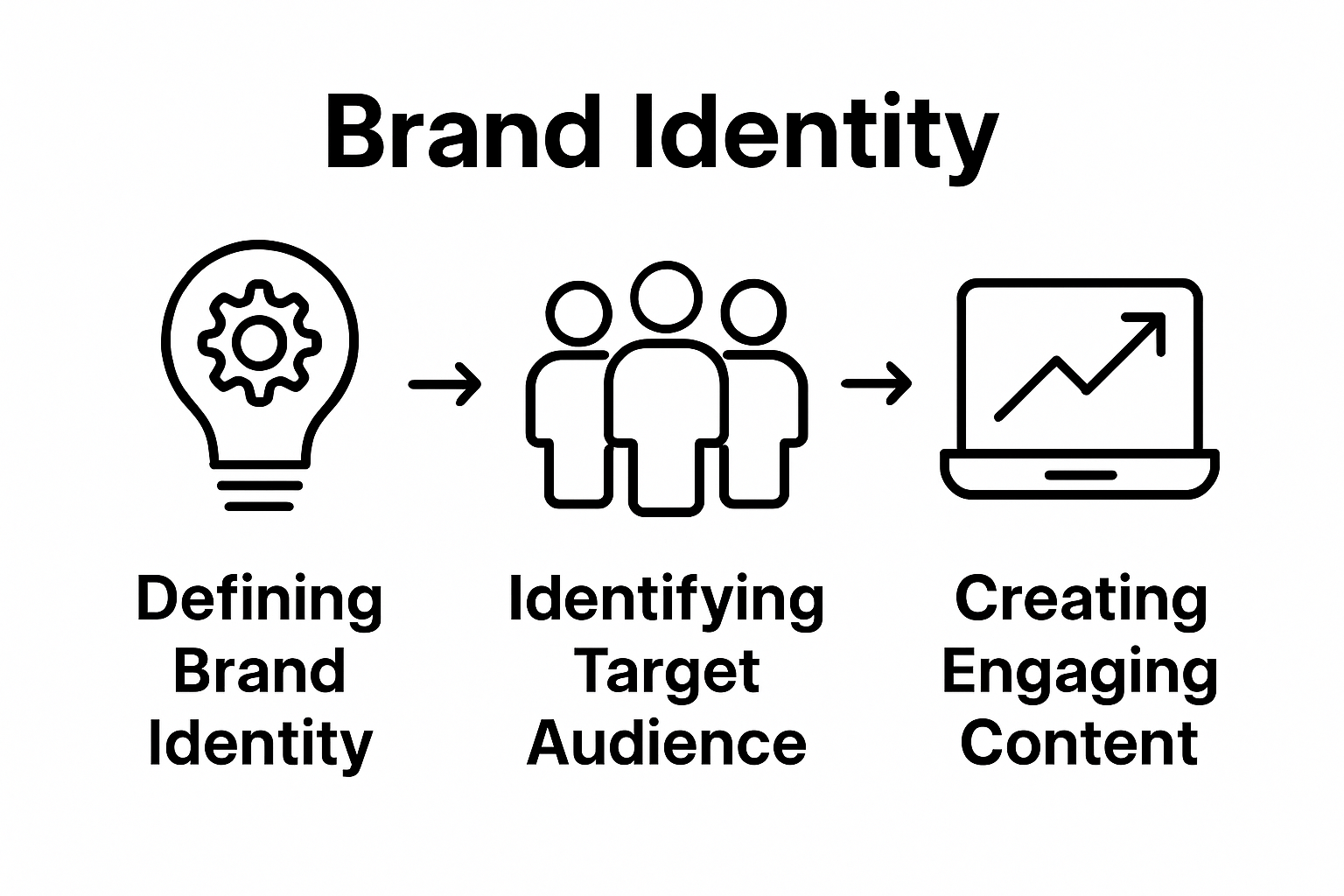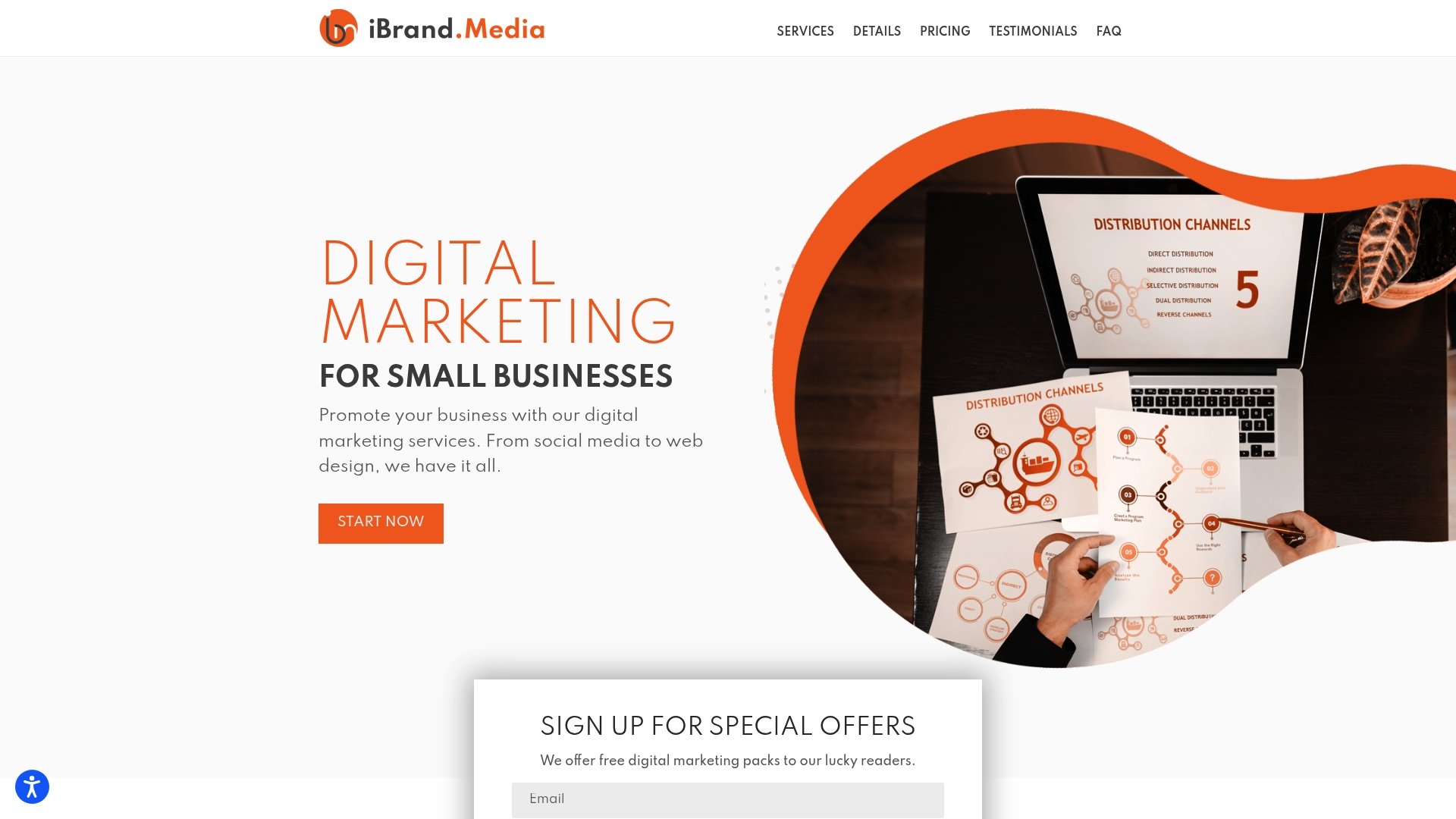Building brand awareness online might sound like just putting your logo everywhere but it is so much more than that. Most businesses fade into the noise because they overlook one key fact: your brand identity can set you apart in seconds and make customers remember you for years. While everyone focuses on flashy ads and viral posts, the real secret lies in crafting a unique, authentic presence that makes people stop, connect, and trust your business from that very first glance.
Table of Contents
- Step 1: Define Your Brand Identity
- Step 2: Identify Your Target Audience
- Step 3: Create Engaging Content
- Step 4: Leverage Social Media Platforms
- Step 5: Monitor And Adjust Your Strategy
- Step 6: Measure Brand Awareness Growth
Quick Summary
| Key Point | Explanation |
|---|---|
| 1. Define Your Brand Identity | Understand your business values and unique offerings to create a cohesive brand personality. |
| 2. Identify Your Target Audience | Develop detailed customer personas to craft personalized messaging for effective engagement. |
| 3. Create Engaging Content | Focus on storytelling that provides value and resonates with your audience’s needs. |
| 4. Leverage Social Media Platforms | Use platforms where your audience is active to build authentic connections and engage consistently. |
| 5. Monitor and Adjust Your Strategy | Regularly analyze performance data to fine-tune your marketing strategies and remain effective. |
Step 1: Define Your Brand Identity
Building brand awareness online begins with a crystal clear understanding of who you are as a business. Your brand identity serves as the foundation for all digital marketing efforts, transforming your business from a generic service provider into a memorable and distinct entity. This critical first step requires deep introspection and strategic planning.
Start by examining the core essence of your business. What fundamental values drive your work? What unique perspective or solution do you offer that sets you apart from competitors? Your brand identity must authentically represent your business’s mission and personality. Consider your target audience and how your brand can genuinely connect with their needs and aspirations.
Develop a comprehensive brand profile that includes several key elements. Your brand voice should reflect your company’s personality whether that means professional and authoritative, friendly and approachable, or innovative and cutting edge. Create a consistent visual language including color schemes, typography, and imagery that communicates your brand’s core message. These visual and tonal elements will become your digital signature across all online platforms.
A strong brand identity requires documenting your unique value proposition specifically addressing how you solve customer problems differently from others in your market. This isn’t just about what you do, but how and why you do it. For small businesses and local service providers, this often means highlighting personal touch points, specialized expertise, or community connections that larger competitors cannot replicate.
Verify your brand identity’s effectiveness by asking critical questions: Can a potential customer understand who you are within seconds of encountering your online presence? Does your digital representation feel cohesive and authentic? Would strangers immediately grasp your business’s core mission? Learn more about crafting a compelling brand strategy to ensure your online identity resonates powerfully with your intended audience.
By meticulously defining your brand identity, you transform from just another business into a memorable, distinct digital presence ready to capture attention and build meaningful connections online.
Below is a checklist table you can use to verify that your brand identity is clearly defined for a strong online presence.
| Verification Step | What to Check | Completion Status |
|---|---|---|
| Clarity of Core Values | Are your business values and mission clearly stated? | [ ] |
| Unique Value Proposition | Is your differentiation from competitors clearly identified? | [ ] |
| Brand Voice Consistency | Does your digital content reflect a consistent tone and persona? | [ ] |
| Visual Identity Established | Are your colors, typography, and imagery cohesive? | [ ] |
| Audience Relevance | Does your identity genuinely connect with target customer needs? | [ ] |
| Easy Recognition | Can someone understand your business within seconds online? | [ ] |
Step 2: Identify Your Target Audience
Identifying your target audience is the critical bridge between your brand identity and successful online marketing. This step transforms your broad business concept into a precise strategy focused on the specific people most likely to connect with your products or services. Understanding who your ideal customers are allows you to craft messaging that resonates deeply and builds genuine connections.
Begin by developing comprehensive customer personas that go beyond basic demographics. These personas should capture not just age and location, but underlying motivations, challenges, and aspirations. Consider the specific problems your business solves and the type of customer most likely to seek those solutions. For local service providers like home contractors or medical professionals, this might mean understanding the precise pain points and preferences of homeowners or patients in your service area.
Utilize multiple research methods to gather insights about your potential customers. Social media analytics, customer surveys, and direct conversations provide rich qualitative data about your audience’s preferences. Google Analytics and platform-specific insights can reveal critical information about who currently interacts with your online content. Pay special attention to the platforms where your ideal customers spend their time whether that means professional networks like LinkedIn for B2B services or visually driven platforms like Instagram for more consumer-focused businesses.
Make your audience research actionable by creating detailed profiles that inform your marketing strategy. Understand not just who your customers are, but how they make decisions, what language they use, and what emotional triggers motivate their choices. For small businesses, this often means recognizing the personal connections and trust factors that drive local customer engagement. Discover advanced audience targeting techniques to refine your approach and maximize your online marketing effectiveness.
Verify the accuracy of your target audience identification by testing your assumptions. Monitor engagement metrics, conduct small-scale marketing experiments, and be willing to adjust your understanding as you gather more real-world data. Your target audience profile is a living document that should evolve with your growing understanding of your customers’ needs and behaviors.
Step 3: Create Engaging Content
Creating engaging content is the powerhouse of building brand awareness online, transforming your digital presence from passive to dynamic. This step moves beyond simply producing material to crafting strategic communication that captures attention, builds trust, and compels your target audience to connect with your brand.
Understand that engaging content is about storytelling, not selling. Your digital content should provide genuine value, addressing your audience’s specific needs, challenges, and interests. For local businesses like home contractors or medical professionals, this means creating content that demonstrates expertise while solving real problems. Share insights that showcase your unique knowledge and approach, whether through detailed guides, behind-the-scenes glimpses, or practical solutions to common customer concerns.
Develop a content strategy that balances different formats to maintain audience interest. Video content, which allows for personal connection, works exceptionally well for service-based businesses. Short tutorial videos, client testimonial clips, or quick expert advice segments can humanize your brand and build credibility. Written content like blog posts and social media updates should be concise, conversational, and packed with actionable information. Focus on creating content that your ideal customer would find genuinely useful or entertaining.
Prioritize authenticity in your content creation. Your digital voice should consistently reflect the brand identity you established earlier. This means maintaining a tone that feels true to your business’s personality whether that’s professional, friendly, innovative, or community-focused. Use real examples from your work, share genuine client success stories, and avoid generic marketing language that feels disconnected from your actual business experience.
Unlock advanced content creation strategies to elevate your online presence. Verify your content’s effectiveness by tracking key engagement metrics like views, shares, comments, and time spent on your digital platforms. A successful content strategy isn’t about perfect production but about consistent, genuine communication that builds meaningful connections with your target audience.

Remember that great content is an ongoing conversation. Stay curious, listen to your audience’s feedback, and be willing to adapt your approach based on what resonates most strongly with potential customers.
Step 4: Leverage Social Media Platforms
Leveraging social media platforms transforms your brand from a static entity into a dynamic, interactive presence. This step is about strategically selecting and mastering digital channels that align perfectly with your target audience and brand identity. Social media offers an unprecedented opportunity to build relationships, showcase your expertise, and create meaningful connections with potential customers.
Choose platforms strategically based on where your ideal customers actually spend their time. For local service providers like home contractors or medical professionals, this might mean prioritizing platforms with strong visual storytelling capabilities and professional networking potential. Facebook and Instagram work exceptionally well for businesses wanting to showcase before-and-after work, share customer testimonials, and demonstrate professional credibility. LinkedIn becomes crucial for B2B service providers seeking to establish thought leadership and professional connections.
Develop a consistent posting strategy that balances professional insights with genuine personal connection. Your social media presence should feel like a natural extension of your brand’s personality. This means creating content that goes beyond promotional messaging to provide real value. Share quick tips related to your industry, behind-the-scenes glimpses of your work process, and authentic stories that humanize your business. Use a mix of educational content, client success stories, and occasional promotional material to keep your audience engaged and interested.
Understand that social media success requires active engagement, not just broadcasting. Respond promptly to comments, participate in relevant conversations, and show that there are real people behind your business brand. Invest time in understanding each platform’s unique features and audience expectations. Instagram might require visually stunning content, while Twitter demands concise, punchy communication. Discover advanced social media optimization techniques to refine your approach and maximize your online impact.
Verify your social media strategy’s effectiveness by tracking key metrics like engagement rates, follower growth, and interaction quality. Success isn’t just about numbers but about creating meaningful connections that translate into real business relationships.
The following table compares major social media platforms and highlights their best use cases for different types of service businesses seeking to build brand awareness online.
| Platform | Best For | Key Features |
|---|---|---|
| Local service businesses | Community engagement, reviews | |
| Visual storytelling, contractors | Photos, stories, reels | |
| B2B professionals, thought leaders | Professional networking, articles | |
| Quick updates, industry insights | Real-time posts, trending topics | |
| YouTube | In-depth tutorials, testimonials | Long-form video, search visibility |
Step 5: Monitor and Adjust Your Strategy
Monitoring and adjusting your brand awareness strategy is the critical final step that transforms your digital marketing from a static plan into a dynamic, responsive approach. This ongoing process ensures your online efforts remain effective, relevant, and aligned with your business goals and audience expectations.
Data is your most powerful ally in understanding your brand’s online performance. Utilize comprehensive analytics tools across your digital platforms to track key performance indicators. Google Analytics, social media insights, and platform-specific tracking tools provide deep insights into how your audience interacts with your content. Pay special attention to metrics like engagement rates, website traffic, content reach, and conversion paths. These numbers tell a story about what resonates with your target audience and where your strategy needs refinement.
Develop a systematic approach to reviewing your analytics. Set aside dedicated time each month to conduct a thorough review of your digital marketing performance. Look beyond surface-level metrics to understand the deeper patterns in audience behavior. Are certain types of content generating more engagement? Which platforms are driving the most meaningful interactions? Are you attracting the right kind of audience that aligns with your ideal customer persona? Be prepared to pivot quickly when data suggests a strategy is not delivering the expected results.
Remember that adjusting your strategy is not about drastic overhauls but incremental improvements. Small, strategic tweaks can significantly enhance your brand awareness efforts. This might mean adjusting your content mix, experimenting with posting times, refining your messaging, or exploring new platforms that better reach your target audience. Learn advanced techniques for digital strategy optimization to stay ahead of the curve and continuously improve your online presence.
Verify your strategy’s effectiveness by establishing clear benchmarks and regularly comparing your performance against these goals. Success in building brand awareness is not about perfection but consistent improvement and genuine connection with your audience. Stay curious, remain adaptable, and view your digital marketing strategy as a living, breathing entity that grows and evolves with your business.
Step 6: Measure Brand Awareness Growth
Measuring brand awareness growth transforms your digital marketing efforts from guesswork into a precise, data-driven strategy. This crucial step allows you to quantify the impact of your online branding initiatives and understand how effectively you are connecting with your target audience. Think of it as taking the pulse of your brand’s digital health and reputation.
Develop a comprehensive measurement framework that goes beyond surface-level metrics. Start by establishing baseline measurements before implementing your brand awareness strategy. Track key indicators such as website traffic, social media follower growth, engagement rates, brand mention volume, and direct search volume for your business name. These metrics provide a holistic view of how your brand is perceived and discovered online. For local service providers like home contractors or medical professionals, pay special attention to local search visibility, Google My Business interactions, and review generation rates.
Utilize both quantitative and qualitative measurement tools to gain a nuanced understanding of your brand awareness. Google Analytics offers robust tracking capabilities for website traffic and user behavior. Social media platforms provide insights into reach, engagement, and audience demographics. Consider implementing branded tracking tools that monitor mentions across digital platforms, giving you a real-time pulse on how often and in what context people are discussing your business. Qualitative measurements like customer feedback, survey responses, and sentiment analysis are equally important in understanding your brand’s digital reputation.
Explore advanced brand tracking techniques to refine your measurement approach. Create a consistent reporting schedule, whether monthly or quarterly, to track your progress systematically. Look for trends in your data that reveal which strategies are most effective in increasing brand visibility. Are certain types of content generating more engagement? Which platforms are driving the most meaningful interactions? Be prepared to adjust your approach based on these insights.
Remember that brand awareness is a long-term investment. Avoid getting discouraged by short-term fluctuations and focus on sustained growth. Celebrate incremental improvements and use data as a tool for continuous learning and refinement. Your goal is to build a brand that becomes increasingly recognizable and trusted within your target market.

Struggling to Stand Out? Let Your Brand Make an Impression Online
If you have been following the step-by-step guide on building brand awareness and feel frustrated by slow progress or unsure about the next move, you are not alone. Many small businesses face the same roadblocks: unclear brand identity, wasted effort on the wrong platforms, or content that does not attract the right audience. Your business deserves more visibility and genuine connections, but the digital world is crowded and challenging.

Now is the best time to move from learning to doing. At ibrand.media, we help you turn knowledge into action with personalized digital marketing plans built for your goals. From SEO optimization to social media management and result tracking, our team removes the guesswork and gives you the tools to track real growth. Explore more ways to strengthen your online presence by visiting our Uncategorized | Ibrandmedia page or head to our homepage to launch your custom strategy today. Do not wait while other brands move ahead—take the next step toward a memorable and profitable online identity now.
Frequently Asked Questions
How can I define my brand identity for online presence?
To define your brand identity, examine your core values, unique offerings, and mission. Create a brand profile that includes your brand voice and visual language to ensure consistency across platforms.
What steps should I take to identify my target audience?
Begin by developing customer personas that include demographics, motivations, challenges, and preferences. Use social media analytics, surveys, and insights from Google Analytics to refine your understanding of your ideal customers.
What types of content are most effective for engaging my audience?
Effective content goes beyond selling and focuses on storytelling, providing genuine value. Consider formats like how-to guides, videos, and client testimonials that showcase your expertise and address audience needs.
How can I measure the effectiveness of my brand awareness strategy?
Utilize analytics tools to track key performance indicators like website traffic, social media engagement, and brand mentions. Establish a baseline before implementing your strategy to compare growth and make necessary adjustments.

Recent Comments